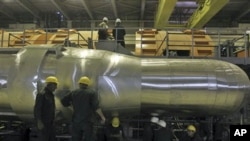Iran's Bushehr nuclear power plant has been completed. Russia, which supplied the reactor, is now training Iranians to operate the facility. And the International Atomic Energy Agency (IAEA), of which Iran is a member, says it is committed to imparting a "culture of nuclear safety" for all member nuclear power operators. As last month's nuclear disaster at Japan's Fukushima power plant shows, such safety considerations can become a life-or-death matter.
Workers at the Fukushima nuclear power plant, north of Tokyo, on the Pacific Ocean coast, have struggled to prevent the spread of radiation following damage incurred by last month's massive earthquake. Their efforts reflect the extensive emergency training they - and other nuclear power workers worldwide - are given. That includes the personnel at Iran's new Bushehr nuclear power plant.
The nuclear power industry will never forget what happened 25 years ago at the Chernobyl facility in Ukraine. There, an experiment with the cooling system - one not provided for in the training regimen - led to a reactor explosion and what became the world's worst nuclear power disaster.
Especially after Chernobyl, the global nuclear power industry has focused on what it calls a "culture of nuclear safety." At The Nuclear Energy Institute, a U.S. trade group, Tony Pietrangelo explains the concept.
"The safety culture exists on a continuum," said Pietrangelo. "You can always work to improve it. It is a questioning attitude. It is professionalism. And again, it is that profound respect for the technology you are dealing with."
One pillar of that safety culture is thorough training for those who will operate nuclear power plants. Russia's state nuclear power entity, ROSATOM, which completed the Bushehr plant after years of delays, is now training the Iranian staff to run it. At the U.S. Broookhaven National Laboratory, senior scientist Upendra Rohatgi describes the training regimen.
"They are providing operator training in terms of classroom [instruction]," noted Rohatgi. "Then also, they have full-scope [covering all situations] simulators, which are the same as western [in terms of] standards, and then, in-plant training."
Like the aircraft simulators that pilots train on, nuclear power operators can learn how to cope with problems and sudden emergencies without making real-life mistakes that could cause fatalities and devastate the environment.
ROSATOM will remain on-site for the immediate future, as it has done with other client nations such as China and India. And the International Atomic Energy Agency (IAEA), of which Iran is a member state, will oversee the plant's operation.
The IAEA sends teams of inspectors to nuclear power plants to ensure that best practices are being followed.
"They look at the training programs, how the operators are trained to cope with accidents on simulators, and so on. And, we also look at the qualifications of people to perform maintenance. And also, the preparation of the plant for possible emergencies," noted former IAEA Nuclear Installation Safety Director Philippe Jamet.
Iran's Atomic Energy Agency has repeatedly said that as an IAEA member, it will follow that U.N. agency's operational and safety protocols at the Bushehr plant.
But what the disaster at Japan's Fukushima plant makes clear is that the severity of natural events, such as a massive earthquake, can overwhelm even the highest levels of training and attention to safety.
This is part three of a three-part series. Click here for part 1 and here part 2.











